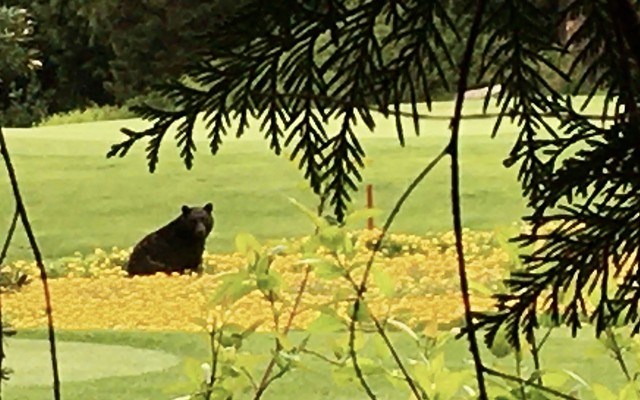I really enjoy walking around the Whistler Golf Club course, and if I am honest, I especially love it in spring when bears crop the grass and literally loll around in the patches of dandelions with the type of splendour reserved for Rubenesque paintings.
And this spring, with many fewer people around, there were quite a few bears鈥攖his has changed now with the course open, of course. But this weekend, as I walked the Valley Trail, I passed a family taking photos of the dad as he played golf while a bear munched on the greens some distance behind him. I stopped, too.
"Is Dad safe?" I overheard a girl, who looked about eight years old, ask. The mom replied by saying words to the effect of, "Yes. He knows to stay away from the bear. Look, it has no cubs, so that is good to know, and remember we learned about what to do last time we were here."
Then the mom said, "I don't think I'll ever forget this."
I have to admit that last statement kind of stopped me in my tracks. I was feeling good overhearing that they had received some education about bear safety in a previous visit, and perhaps even a bit smug that Whistler was, in this case, on top of its bear education.
But what had been initially lost in all of this to me was the true value of visitors seeing nature and its creatures in real life, until the mom spoke up.
This cannot be taken away by a pandemic and it remains as authentic and experiential as it ever was, and more important than ever as we face our "new normal" in tourism.
We can't forget that bears are wild and, as such, are unpredictable. We can never imagine that they are "assets" in our tourism story, but they do play a role.
This also means our community has a deep and profound responsibility for any of our behaviours that impact bears鈥攂oth black bears and grizzlies.
Last week, the B.C. Court of Appeal found that former conservation officer Bryce Casavant (who refused to kill two bears cubs and was then then fired for it in 2015), was improperly terminated.
While this is important as a vindication for Casavant, its implications run deeper because the court found that as a conservation officer, his actions are governed by the Police Act and not the Labour Relations Board.
This means that actions by COs should be considered akin to police constables鈥攁nd, as such, have civilian oversight.
In January, the conservation group Pacific Wild, which works with Casavant, found that more than 4,500 bears had been killed by conservation officers in the province over the last eight years, including 4,341 black bears (780 cougars were also killed).
"[British Columbia] isn't a shooting gallery for government employees," Casavant wrote in the Pacific Wild report. "It's unreasonable to believe that, including juvenile bear cubs, over 4,000 black bears were killed 'as a last resort.'"
Last year, the same group reported that 500 black bears and 26 grizzlies were killed.
The group sent a letter to Environment Minister George Heyman in January asking that the Conservation Officer Service make independent oversight a priority in 2020 and to have all field officers outfitted with body cameras.
So far, nothing has changed.
I believe there has been a change in Whistler over the last year, with it being clearly communicated that as a community, we do not support the killing of bears unless absolutely necessary. It is up to us to protect these important creatures.
Last year, just two bears were killed by COs and one of those bears was hit by a car. Five bears were relocated. This year, we are in June and so far no bears have been killed and five were relocated, with three of those being one family.
This year, we have also had sightings of a grizzly bear in the community. While some may view this as alarming, it is a testament to the hard work that has been going on for years to help protect the grizzly population in the Sea to Sky region.
Normally, they keep to the backcountry, but as recreationalists move further and further afield to hike and bike, it is very likely that encounters will become more common. The Resort Municipality of Whistler and other stakeholders have been addressing issues around this for some time.
But again, it is human behaviour that will have the greatest impact.
This week, longtime resident Brad Sills, also the Whistler Search and Rescue manager, shared some great advice about recreating in grizzly country: behave in the same way as if you were heading out into the backcountry during a period of high avalanche risk.
You need to educate yourself about the risk, where it is highest and avoid that area. You also need to be able to self-rescue and you need to be prepared for the encounter.
Let's be clear: it is up to humans to co-exist with bears, not the other way around.




